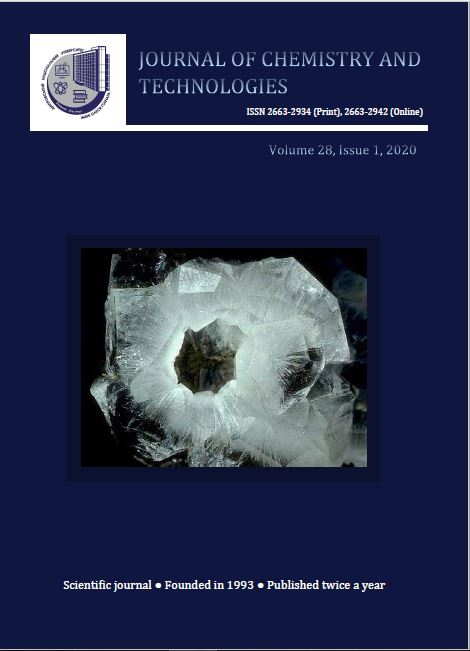MONITORING OF CONTENT OF SODIUM, POTASSIUM, CALCIUM AND MAGNESIUM IN WHEY PROCESSED PRODUCTS
DOI:
https://doi.org/10.15421/082004Keywords:
whey, triton X-100, ultrasound, atomic absorption spectroscopy, inductively coupled plasma atomic emission spectroscopy.Abstract
The influence of Triton X-100 concentration and time of ultrasonic treatment (frequency 44 kHz, intensity 1.5 W/cm2) on the determination of sodium, potassium, calcium and magnesium in whey processed products by atomic absorption spectroscopy (AAS) was studied. It was shown that the maximum value of the analytical signal is achieved with a mass fraction of Triton X-100 of 5 % and an ultrasonic treatment time of 15 min. The sensitivity of measurements increases from one and a half to two times. Procedures have been developed for determining the content of sodium, potassium, calcium and magnesium in whey and products of its processing by AAS and atomic emission spectroscopy with inductively coupled plasma (AES-ICP). Validation of the results of determination of magnesium and calcium by AAS and AES-ICP was carried out by varying the weight of the sample and standard addition method.
References
Onwulata, C. I. (2004). Milk whey processes: Current and future trends. In Whey Processing, Functionality and Health Benefits. Oxford, UK: Wiley-Blackwell. https://doi.org/10.1002/9780813803845.ch14
Hramcov, A. G. (2011). [The phenomenon of whey]. St.Petersburg: Professiya (in Russian).
Nesterenko, P. G., Evdokimov, I. A., Hramcov, A. G. (2008). [Historical aspects of the use and processing of whey] // Molochnaya promyshlennost. 11, 32-34 (in Russian).
Volodin, D. N., Zolotoreva, M. S., Topalov, V. K., Evdo-kimov, I. A., Hramcov, A. G., Mertin, P. V. (2015). [Whey processing: clear strategy, real technology, ad-equate investment, sought after products]. Molochna-ya promyshlennost. 5, 111 (in Russian).
Hramcov, A. G., Nesterenko, P. G. (2014). [Whey Products Technology ]. M.: DeLi print, 2014. – 587 p. (in Russian).
Gupta, C., Prakash, D. (2017). Therapeutic Potential of Milk Whey. Beverages, 3(4), 31.
https://doi.org/10.3390/beverages3030031
Deeth, H. C., Bansal, N. (2019). Whey Proteins, from milk to medicine. Amsterdam: Elsevier.
Michaelidou, A., Steijns, J. (2006). Nutritional and technological aspects of minor bioactive components in milk and whey: Growth factors, vitamins and nucleo-tides. Int. Dairy J. 16(11), 1421–1426.
https://doi.org/10.1016/j.idairyj.2006.06.018
Park, Y. W. (Ed.). (2009). Bioactive Components in Milk and Dairy Products. Wiley-Blackwell.
Evdokimov, I. A., Bessonov, A. S., Zolotareva, M. S., Poverin, A. P. (2010). [Real membrane technologies]. Molochnaya promyshlennost. 1, 49-50 (in Russian).
Evdokimov, I. A., Volodin, D. N., Somov, V. S., Chablin, B. V., Mihneva, V. A., Zolotoreva, M. S. (2013). [Mem-brane technologies in dairy production]. Molochnaya promyshlennost. 9, 15-18 (in Russian).
Poitevin, E. (2016). Official Methods for the Determi-nation of Minerals and Trace Elements in Infant For-mula and Milk Products: A Review. Journal of AOAC In-ternational, 99(1), 42–52.
https://doi.org/10.5740/jaoacint.15-0246
Pacquette, L. H., Thompson, J. J., Malaviole, I., Zywicki, R., Woltjes, F., Ding, Y., Mittal, A. I., Sadipiralla, B., Ki-mura, S., Veltman, H., Miura, A. (2018). Minerals and trace elements in milk, milk products, infant formula, and adult/pediatric nutritional formula, ICP-MS meth-od: Collaborative study, AOAC final action 2015.06, ISO/DIS 21424, IDF 243. Journal of AOAC International, 101(2), 536–561. https://doi.org/10.5740/jaoacint.17-0318
Chmilenko, F. A., Smityuk, N. M., Baklanov, A. M. (2002). Atomic absorption determination of metals in soils using ultrasonic sample preparation. J. Anal. Chem. 57, 313–318. https://doi.org/10.1023/A:1014946213773
Chmilenko, F. A., Baklanov, A. M., Sidorova, L. P., Levedeva, E. V., Lebvedeva, A. V. (2001). Ultrasonic intensification of sample preparation for the spectro-photometric determination of arsenic in foodstuffs. J. Anal. Chem. 56, 13–16.
https://doi.org/10.1023/A:1026755025799
Baklanov, A. M., Chmilenko, F. A. (2001). Use of ultra-sound in sample preparation for the determination of mercury species by cold-vapor atomic absorption spec-trometry. J. Anal. Chem. 56 (7), 641–646. https://doi.org/10.1023/A:1016792205748
Baklanov, A. M., Chmilenko, F. A. (2000). Determina-tion of Alkali and Alkaline-Earth elements in table salt and sodium chloride by sonoluminescence. J. Anal. Chem. 55 (12), 1152–1154.
https://doi.org/10.1023/A:1026610919456
Karpov, Yu. A., Savostin, A. P. (2015). [Sampling and sample preparation methods]. Moscow, Russian Fed-eration: Izdatelstvo BINOM. Laboratoriya znanij (in Russian).
Vishnikin A. B. (2005) Novel indirect spectrophoto-metric methods for determination of phosphate and arsenate using polyoxometalates and micellar medi-um. J. Molec. Liquids, 118(1-3), 51-55. https://doi.org/10.1016/j.molliq.2004.07.012
Yurchenko, O. I., Kharenko, I. P. (2007). Increasing the sensitivity of atomic absorption determination of iron. Journal of Applied Spectroscopy, 74(2), 295–299. https://doi.org/10.1007/s10812-007-0046-3
Downloads
Published
Issue
Section
License
Copyright (c) 2020 Дніпровський національний університет імені Олеся Гончара

This work is licensed under a Creative Commons Attribution 4.0 International License.
- Authors reserve the right of attribution for the submitted manuscript, while transferring to the Journal the right to publish the article under the Creative Commons Attribution License. This license allows free distribution of the published work under the condition of proper attribution of the original authors and the initial publication source (i.e. the Journal)
- Authors have the right to enter into separate agreements for additional non-exclusive distribution of the work in the form it was published in the Journal (such as publishing the article on the institutional website or as a part of a monograph), provided the original publication in this Journal is properly referenced
- The Journal allows and encourages online publication of the manuscripts (such as on personal web pages), even when such a manuscript is still under editorial consideration, since it allows for a productive scientific discussion and better citation dynamics (see The Effect of Open Access).


